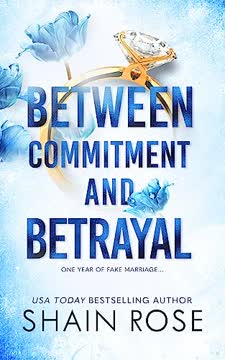Plot Summary
Diagnosis and Devastation
Clara receives a life-altering diagnosis—lupus, a chronic, incurable disease. The news is delivered with clinical detachment, leaving her reeling and alone. She tries to mask her pain, both physical and emotional, as she faces a day already heavy with grief: her beloved stepfather's will is to be read. The weight of her illness is compounded by the absence of support from her family, and the knowledge that her future is now uncertain. Clara's vulnerability is palpable, her resilience tested, and her sense of self-worth begins to erode under the pressure of secrets she feels she must keep. The chapter sets the tone for a journey defined by struggle, isolation, and the desperate hope for something—someone—to hold onto.
The Will's Unorthodox Stipulation
At the reading of her stepfather's will, Clara is shocked to learn that her future is now entwined with Dominic Hardy, her stepfather's protégé and the eldest of the Hardy brothers. The will's stipulation: Dominic inherits the Pacific Coast Resort, but only if he includes Clara's bakery in the grand reopening. Both are blindsided—Dominic by the intrusion into his meticulously planned project, Clara by the loss of her original bakery and the daunting prospect of starting anew. Their mutual disdain is immediate and electric, but the will's terms are ironclad. The chapter brims with tension, as two people who loathe each other are forced into reluctant partnership, setting the stage for a battle of wills and hearts.
Enemies Bound by Blueprints
Dominic and Clara are thrust into a working relationship neither wants. Dominic, a perfectionist architect, sees Clara's bakery as a blemish on his vision; Clara, still grieving and ill, is determined to make her mark. Their interactions are laced with sarcasm, barbs, and simmering resentment. Family dynamics complicate matters—Clara's mother and sister are manipulative and cruel, while Dominic's loyalty to his own family is unwavering. The two clash over every detail, from design aesthetics to business strategy, each refusing to yield. Yet, beneath the antagonism, a grudging respect begins to flicker, hinting at the possibility of something more.
Family Ties and Fractures
Clara's home life is a minefield. Her mother and sister belittle her ambitions, dismiss her illness, and undermine her confidence at every turn. Dominic witnesses the emotional abuse and, despite his own reservations, feels compelled to protect her. The contrast between Clara's fractured family and Dominic's close-knit, if chaotic, siblings is stark. As Clara is pushed to the brink by her family's cruelty, she begins to see the Hardy family as a model of what she's always longed for—unconditional support. The emotional stakes rise, and Clara's need for independence collides with her yearning for belonging.
Reluctant Partners, Relentless Clash
The bakery's design process is a microcosm of Clara and Dominic's relationship: every choice is a battle. Clara's love of color and warmth is at odds with Dominic's sleek, monochrome vision. Their arguments are fierce, but so is their drive to succeed. As they are forced to compromise, moments of vulnerability slip through—Clara's illness flares, Dominic's past heartbreak surfaces. The tension between them shifts from purely antagonistic to something more complex, charged with unspoken attraction and mutual frustration. The bakery, once a symbol of conflict, becomes a crucible for transformation.
Color Wars and Compromise
Clara's insistence on infusing her bakery with color becomes a stand against Dominic's rigid control. She sneaks in pink paint, pastel seating, and floral accents, only to have them erased by Dominic's designer. The struggle is about more than aesthetics—it's about identity, agency, and the right to take up space. Dominic, challenged for the first time in years, is both infuriated and intrigued by Clara's defiance. Their push-pull dynamic intensifies, and the lines between professional and personal begin to blur. Compromise is hard-won, but it plants the seeds of trust.
The Bakery Becomes Battleground
As the bakery nears completion, the stakes grow higher. Clara's health deteriorates under the stress, and Dominic's protectiveness deepens. Their arguments become more intimate, their chemistry undeniable. A late-night confrontation in the bakery explodes into a moment of raw vulnerability and desire, shattering the barriers between them. For the first time, they see each other's wounds—Clara's fear of never being enough, Dominic's terror of losing control. The bakery, once a site of loathing, becomes the place where love and loathing collide, and something new is forged.
Lines Blurred, Boundaries Crossed
The shift from adversaries to lovers is messy, passionate, and fraught with risk. Clara and Dominic's connection is electric, but their baggage threatens to pull them apart. Clara's illness is a constant shadow, and Dominic's past with his ex, Natya, looms large. Their relationship is tested by jealousy, miscommunication, and the ever-present demands of the resort. As they navigate the treacherous waters of intimacy, they must decide if they can trust each other with their deepest fears—or if their love will be another casualty of their war.
Secrets, Sickness, and Sabotage
Clara's lupus flares dangerously, and her secret is exposed to Dominic. The revelation is a turning point—Dominic's anger at being kept in the dark is matched only by his fear for her safety. Meanwhile, sabotage threatens the bakery's success, and family betrayals cut deep. Dominic's ex stirs up trouble, and Clara's mother and sister exploit her vulnerability. The couple is forced to confront the reality that love alone may not be enough to overcome the obstacles in their path. The cost of independence, and of letting someone in, becomes painfully clear.
The Cost of Independence
Clara's determination to stand on her own is both her greatest strength and her Achilles' heel. She pushes herself to the brink, risking her health and happiness to prove her worth. Dominic, desperate to protect her, struggles to respect her autonomy. Their love is put to the ultimate test as Clara faces a medical crisis, and Dominic must decide if he can let go of control. The chapter is a meditation on the price of freedom, the meaning of partnership, and the courage it takes to ask for help.
Love in the Line of Fire
The resort's grand reopening is a dazzling spectacle, but behind the scenes, Clara and Dominic's relationship is unraveling. The press hounds them, Dominic's ex manipulates the narrative, and Clara's family resurfaces with fresh demands. Under the glare of the spotlight, old wounds are reopened and new ones inflicted. The couple's love is tested by external pressures and internal doubts. In the crucible of public and private pain, they must decide if their bond is strong enough to survive—or if it will be consumed by the fire.
The Resort's Grand Reopening
The culmination of months of struggle, the grand reopening is both a professional triumph and a personal reckoning. Clara's bakery is a hit, her vision finally realized. But the night is marred by confrontation with Dominic's ex, family drama, and the resurgence of Clara's illness. The couple's love is laid bare—imperfect, hard-won, and deeply vulnerable. In the aftermath, they are forced to confront the truth: to move forward, they must let go of the past and embrace the messy, beautiful reality of their present.
Ghosts of Lovers Past
Dominic's unresolved feelings for his ex, and Clara's fear of being second best, come to a head. Misunderstandings and half-truths drive a wedge between them. The specter of past heartbreak haunts their every interaction, and the risk of repeating old patterns looms large. Both must confront the ghosts that have shaped them—Dominic's guilt and grief, Clara's longing for acceptance—and decide if they can build a future unburdened by the past. The chapter is a raw exploration of forgiveness, self-worth, and the power of letting go.
Breaking Points and Breakups
The pressure becomes too much, and Clara and Dominic part ways. The breakup is devastating, but necessary. Clara learns to stand on her own, to value herself beyond her relationships. Dominic is forced to reckon with his own flaws, to confront the ways he has hurt those he loves. Both are changed by the experience—humbled, wiser, and more compassionate. The pain of separation is a crucible, burning away illusions and leaving only what is real. In the silence that follows, they discover what truly matters.
Owning the Pain, Owning the Love
Time apart brings clarity. Clara confronts her family, sets boundaries, and claims her place in the world. Dominic, realizing the depth of his love, takes bold steps to win her back—not with grand gestures, but with everyday acts of care and respect. They learn that love is not about perfection, but about showing up, owning mistakes, and choosing each other again and again. The chapter is a testament to the power of vulnerability, the necessity of forgiveness, and the beauty of loving—and being loved—without reservation.
Healing, Home, and Hope
Reunited, Clara and Dominic create a home that reflects both their strengths and their wounds. They navigate the challenges of chronic illness, family drama, and the demands of their careers with humor, grace, and fierce loyalty. Their love is not a fairy tale, but a hard-won reality—messy, imperfect, and deeply satisfying. Together, they learn that healing is a journey, not a destination, and that hope is found in the everyday moments of connection and care. The future is uncertain, but they face it hand in hand.
A Future Fought For
The story concludes with Clara and Dominic embracing the life they have built—one defined by love, loathing, and everything in between. They celebrate their victories, mourn their losses, and look to the future with courage and optimism. Their journey is a testament to the power of resilience, the importance of self-worth, and the transformative potential of love. In the end, they choose each other—not because it is easy, but because it is real. Their story is a reminder that the greatest battles are fought not against each other, but alongside one another, for a future worth fighting for.
Characters
Clara Milton
Clara is a talented baker whose life is upended by a lupus diagnosis and the loss of her beloved stepfather. Her relationship with her mother and sister is toxic, marked by emotional abuse and manipulation. Despite her vulnerability, Clara is fiercely independent, determined to carve out a space for herself in a world that constantly undermines her. Her journey is one of self-discovery—learning to value her own needs, set boundaries, and accept love without losing herself. Clara's illness is both a source of pain and a catalyst for growth, forcing her to confront her limitations and embrace her strengths. Her relationship with Dominic is transformative, challenging her to fight for what she wants and to believe she is worthy of happiness.
Dominic Hardy
Dominic is the eldest of the Hardy brothers, a brilliant and exacting architect whose life is defined by control and achievement. Scarred by a past relationship with his ex, Natya, Dominic is wary of vulnerability and fiercely protective of his heart. His initial disdain for Clara masks a deep-seated fear of losing control—over his work, his emotions, and his carefully constructed world. As he is drawn into Clara's orbit, Dominic is forced to confront his own flaws, to let go of perfection, and to risk his heart again. His journey is one of redemption, learning that true strength lies in vulnerability and that love is not about possession, but partnership.
Melinda Milton (Clara's Mother)
Melinda is a master of emotional manipulation, using guilt, shame, and cruelty to control her daughters. Her obsession with status and appearances drives a wedge between her and Clara, fueling Clara's insecurities and self-doubt. Melinda's inability to accept Clara's illness or ambitions is a constant source of conflict, and her presence looms large even in her absence. She represents the toxic legacy Clara must overcome to find happiness.
Anastasia Milton (Clara's Sister)
Anastasia is both victim and perpetrator, echoing their mother's cruelty while also suffering under it. Her relationship with Clara is fraught—sometimes supportive, often undermining. Anastasia's inability to break free from their mother's influence is a cautionary tale, highlighting the difficulty of escaping toxic family dynamics. Her eventual betrayal is a turning point for Clara, forcing her to choose herself.
Natya Fitch (Dominic's Ex)
Natya is a force of chaos, using charm and manipulation to maintain her hold on Dominic. Her presence is a constant threat to Clara and Dominic's relationship, embodying the dangers of unresolved trauma and the power of the past to shape the present. Natya's actions force Dominic to confront his own fears and to choose between the safety of the familiar and the risk of new love.
Paloma
Paloma is Clara's confidante and cheerleader, offering support, humor, and tough love. Her own struggles with self-worth mirror Clara's, and their friendship is a source of strength for both. Paloma's willingness to stand up for herself—and for Clara—serves as a model of healthy boundaries and self-advocacy.
Declan Hardy
Declan is Dominic's brother and Clara's stepbrother by marriage. His marriage to Evie, Clara's stepsister, symbolizes the blending of families and the possibility of healing old wounds. Declan's loyalty to both Clara and Dominic is unwavering, and his presence is a stabilizing force amid the chaos.
Evie Hardy
Evie's journey from outsider to family is a parallel to Clara's own quest for belonging. Her support during Clara's darkest moments is a lifeline, and her willingness to confront their mother on Clara's behalf is a turning point. Evie represents the family we choose, rather than the one we are born into.
Rita O'Hara
Rita is Dominic's trusted designer, fiercely protective of his vision and dismissive of Clara's. Her resistance to change is both a challenge and an opportunity for Clara, forcing her to fight for her ideas and to assert her worth. Rita's eventual acceptance is a hard-won victory, symbolizing the power of persistence.
Valentino
Valentino is a world-renowned chef whose interest in Clara sparks Dominic's jealousy and forces both to confront their feelings. His presence is a reminder that love is a choice, not a foregone conclusion, and that competition can clarify what truly matters.
Plot Devices
Forced Proximity and Enemies-to-Lovers
The will's stipulation that Clara and Dominic must collaborate on the bakery is the engine that drives the plot. Their initial animosity is heightened by forced proximity, creating a crucible in which attraction and vulnerability can emerge. The enemies-to-lovers trope is used to explore themes of trust, forgiveness, and the transformative power of love.
Chronic Illness as Catalyst and Obstacle
Clara's lupus is both a source of conflict and a catalyst for growth. It tests her resilience, challenges her independence, and forces her to confront her own limitations. The illness is not merely a plot device, but a lens through which issues of self-worth, vulnerability, and care are explored. It also serves as a crucible for Dominic, forcing him to let go of control and to love without conditions.
Toxic Family Dynamics
The toxic relationships with Clara's mother and sister, and Dominic's unresolved past with Natya, are central obstacles. These dynamics are used to explore the ways in which family shapes our sense of self, our capacity for love, and our ability to set boundaries. The contrast between Clara's family of origin and the found family she builds with the Hardys is a key theme.
Symbolism of Color and Design
The battle over the bakery's design is a metaphor for the struggle to assert identity and claim space in a world that demands conformity. Color becomes a symbol of life, hope, and self-expression, while Dominic's monochrome vision represents control and fear. The eventual blending of their styles is a visual representation of compromise, partnership, and the beauty of imperfection.
Public Versus Private Selves
The resort's grand reopening, the scrutiny of the press, and the manipulations of Dominic's ex all serve to test the couple's relationship. The tension between public image and private reality is a recurring motif, highlighting the difficulty of maintaining authenticity in a world obsessed with appearances.
Redemption and Second Chances
Both Clara and Dominic are haunted by past failures—Clara's inability to stand up to her family, Dominic's guilt over his ex and his need for control. Their journey is one of redemption, learning to forgive themselves and each other, and to choose love in the face of fear.
Analysis
Between Love and Loathing is a contemporary romance that uses the enemies-to-lovers trope to explore the complexities of self-worth, vulnerability, and the transformative power of love. At its core, the novel is about two people scarred by family, illness, and past heartbreak, who are forced—by circumstance and by the terms of a will—to confront their deepest fears and desires. The story is as much about healing as it is about romance: Clara's journey from self-doubt to self-acceptance is mirrored by Dominic's evolution from control to compassion. The novel interrogates the ways in which we are shaped by our families, the courage it takes to set boundaries, and the necessity of choosing ourselves before we can truly choose another. The symbolism of color versus monochrome, the motif of design as self-expression, and the recurring theme of public versus private selves all serve to deepen the emotional resonance of the narrative. Ultimately, Between Love and Loathing is a testament to the resilience of the human spirit, the importance of found family, and the hard-won beauty of loving—and being loved—without reservation. The lesson is clear: love is not about perfection, but about showing up, owning our flaws, and choosing each other, again and again, in the face of life's inevitable messiness.
Last updated:
Review Summary
Between Love and Loathing received mixed reviews. Many readers loved the steamy romance and chemistry between the main characters, praising the author's ability to write compelling alpha males and spicy scenes. However, others criticized the lack of character development, choppy writing style, and unrealistic plot progression. Some found the book addictive despite its flaws, while others couldn't finish it. The chronic illness representation was appreciated by some readers. Overall, the book seems polarizing, with passionate fans and equally passionate detractors.








